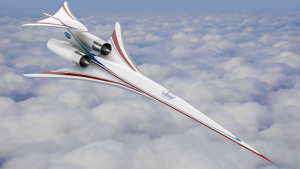Jul 25 2017
The Speed of Commercial Jets
 When I was about 10 my family flew to California to visit my uncle. The flight from New York to LA took about 6 hours. Forty years later a flight from New York to LA still takes about 6 hours (exact flight times vary by airline, but 6 hours is typical).
When I was about 10 my family flew to California to visit my uncle. The flight from New York to LA took about 6 hours. Forty years later a flight from New York to LA still takes about 6 hours (exact flight times vary by airline, but 6 hours is typical).
The pace of technological advance in the last century has been so fast that we generally expect everything to get faster, better, cheaper as a matter of course. So the flat commercial travel times seems to be a weird exception.
Airline travel has improved over this time. Jets have become safer and more fuel efficient. Average costs of flights have decreased by about 50%, although apparently this had more to do with deregulation than technology. It may also have something to do with the shrinking legroom in economy class. But still, why does it take me 6 hours to fly across the country?
There are a number of reasons for the flat commercial flight speeds, which make it seem that there is unlikely to be a change anytime soon.
Supersonic Flight
The first factor that most people likely consider is that we are pushing up against the sound barrier. This is partly true, but not the whole story. The Concorde, which was the only commercial supersonic jet, was retired in 2003. This was mainly because flights were too expensive and it wasn’t commercially viable. There have been no plans to bring it back or replace it.
There are frequent news reports about this or that company working on a supersonic design, but these never seem to get past the concept stage. NASA has been working on developing commercially viable supersonic flight. They gave a contract to Lockheed Martin to develop low sonic-boom technology (QueSST – Quiet Supersonic Travel).
These types of projects lead to countless news reports of “Flying from New York to LA in 2 hours.” Despite 20 years of such headlines, it doesn’t seem as if we are any closer.
The idea is solid, however. The sonic boom is a huge limiting factor. It is, in fact, currently illegal for commercial jets to fly faster than Mach 1.o (the speed of sound in air) over land in the US. The Concorde only flew intercontinental flights for that reason. This is because the noise is too disruptive and even potentially damaging.
So, developing technology to limit the sonic boom is probably a necessary step if we are to ever have significant supersonic commercial flights. It may still not be enough, however.
Further, even approaching Mach 1.0 is problematic because of something called the critical mach number. As planes approach Mach 1.0 the airspeed across parts of the frame may exceed 1.0, even if the plane itself isn’t. So planes have to stay below the critical mach number.
Boeing tried to address this issue with their Sonic Cruiser, which was designed to achieve Mach 0.98. They cancelled the development of this jet in 2002, however, and shifted instead to the Dreamliner, which has a cruising speed of Mach 0.85.
But there is yet another issue that may be the ultimate limiting factor – cost efficiency. The dropping price of airline travel has been great for consumers, but has significantly reduced margins for the industry. This has resulted in some annoyances, like paying for luggage, less leg room, and getting fewer amenities in flight. But hey, I would rather have a cheaper flight than pay more to get a non-crappy meal on the plane.
Another result, however, is that airline are highly motivated to make each flight as cost effective as possible. Airspeed is part of this calculation. As jets go faster, air resistance increases fuel use. Drag is about proportional to square of velocity. This means that a 10% increase in speed results in a 21% increase in fuel use.
Airlines, therefore, calculate optimal speed for cost efficiency. The sweet spot is about Mach 0.85, so that is where most airlines operate. A six hour flight at Mach 0.85 would take 5:22 at Mach 0.95. The shorter flight would be nice, but not worth the extra fuel cost. Most people would likely notice the higher ticket cost than the slightly faster travel time.
The time saving would be more noticeable on longer flights, but there already is higher fuel costs on longer flights because the jets have to carry more fuel for the longer range. For this reason some of the longest routes were canceled. In any case, on longer flights the airlines have even more of an incentive to keep at the optimal speed for fuel use, rather than flight time.
While jet design has certainly improved and will continue to improve, the result of these advances has been in reduced ticket cost, not reduced flight time. It seems like this is going to continue to be the cast for the foreseeable future – we are stuck cruising at Mach 0.85.
This will only change when commercial supersonic flight becomes viable. Reducing the sonic boom will help, but by itself won’t be enough. The overall cost of such flights would have to come down to the point that enough flyers would be willing to pay the premium for the convenience.
At the end of the day flight times have more to do with economics than technology. While I am hopeful that NASA’s project will bear fruit, if I had to predict, I doubt I will ever take a commercial supersonic flight.






